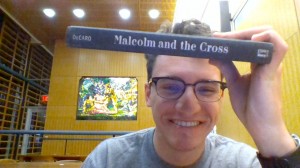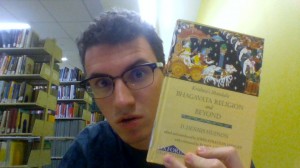DeCaro, Louis A. Malcolm and the Cross: The Nation of Islam, Malcolm X, and Christianity. New York and London: New York University Press, 1998.
Malcolm and the Cross
After reading two articles concerning Malcolm X and the Nation of Islam, I headed over to the Library Catalog and searched “Nation of Islam.” While we tend to relate the Civil Rights movement to Martin Luther King and Rosa Parks and their nonviolence ideology, Malcolm X played a crucial role, providing a radical voice that called for a separate black country in America. This sort of radicalism is what created the polarizing personality of Malcolm X. To find the root of his beliefs, I realized works concerning the Nation of Islam would provide good background. I immediately found multiple books and articles and decided on Malcolm and the Cross: The Nation of Islam, Malcolm X, and Christianity. Looking over the subjects covered in the book, it was clear that this book dealt with Malcolm X as a religious figure and the, sometimes hostile, relations between Islam and Christianity.
The book, in relatively poor condition, was clearly old; however its age added to its allure. The book is divided into two main parts: “Fires Which Burn Brightly: The Nation of Islam in a Christian World” and “X and the Cross: Malcolm, the Nation of Islam, and Christianity.” Each of these sections have subchapters, the first sections focusing on the founding of the Nation of Islam and its spread via Elijah Muhammad, and the second section focusing on the personality and philosophies of Malcolm X. The second section particularly interested me as I hoped to learn more about the man that was Malcolm X, a man that I had never really understood. It is clear to see that he was a man of deep religious and philosophical thought, attempting to navigate through pre-Civil Rights America with Islam as his foundation. Many of the chapters are titled with quotes from him, while the rest focus on his position in a Christian-dominated country where his voice was quieted because of the color of his skin. Malcolm X felt it his duty to tear down the racial hierarchy in America by undermining “white naturalization.” He is quoted as having said that Jesus was depicted as white “to maneuver him into worshiping the white man.” He said that much of history had been “whitened,” including historical black figures. White supremacy had permeated into every aspect of life, such as in the portrayal of a white Jesus as compared to a black Devil. It is this deep level of thinking and realization that Malcolm X had achieved and motivated him to make a change.
Just from skimming through these few chapters, the character of Malcolm X is one that would take a whole semester to understand. Near this book, I found other texts concerning the Nation of Islam and black religion. Elijah Muhammad, the man who inspired Malcolm X before X’s departure from the Nation of Islam, would without a doubt be another interesting character to explore. Both of these men and the message they promoted would be fascinating to research. I believe that their radical beliefs and philosophies make them all the more interesting.

